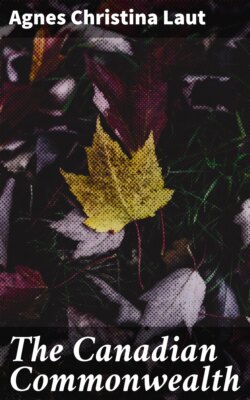Читать книгу The Canadian Commonwealth - Agnes Christina Laut - Страница 11
На сайте Литреса книга снята с продажи.
IV
ОглавлениеTable of Contents
When one comes to Ontario, one is dealing with the kitchen garden of the Dominion—in summer a land of placid sky-blue lakes, and amber-colored wooded rivers, and trim, almost garden-like farms, and heavily laden orchards, and thriving cities beginning to smoke under the pall of the increasing and almost universal factory. Under its old boundaries Ontario stood just eighteen thousand square miles larger than France. Under its new boundaries extending to Hudson Bay, Ontario measures almost twice the area of France. France supports a population of nearly forty millions; Ontario, of barely two and a half millions. Both Ontario and France are equally fertile and equally diversified in fertility. Along the lakes and clustered round Niagara is the great fruit region—vineyards and apple orchards that are gardens of perfection. North of the lakes is a mixed farm region. Parallel with the latitude skirting Georgian Bay begins the Great Clay belt, an area of heavily forested lands about seven hundred miles north to south and almost a thousand diagonally east to west. On its southern edge this hinterland, which forms the watershed between Hudson Bay and the St. Lawrence, seems to be rock-bound and iron-capped. For years travelers across the continent must have looked through the car windows across this landscape of windfall and fire as a picture of desolation. Surely, “here was nothing,” as some of the first explorers said when they viewed Canada from Labrador; but pause; not so fast! Here lay, if nothing else, an area of timber limits seven hundred by one thousand miles; and as the timber burned off curious mineral outcroppings were observed. When the railroad was graded through what is now known as Sudbury, there was a report of a great find of copper. Expert after expert examined it, and company after company forfeited options and refused to bond it. Finally a shipment was sent out to a smelter across the border. The so-called “copper” was pronounced “nickel”—the greatest deposit of the metal needed for armor plating known in the world. In fact, only one other mine could compete against the Sudbury nickel beds—the French mines of New Caledonia. Here was something, surely, in this rock-bound iron region of desolation, which passing travelers had pronounced worthless.
The discovery of silver at Cobalt came by an almost similar chance. Grading an extension of a North Ontario railroad projected purely for the sake of prospective settlers, workmen came on surface deposits of “rose” silver—almost pure metal, some of it; and there resulted such a mining boom and series of quick fortunes as had made Klondike famous. And Cobalt and Sudbury are at only the southern edge of the unexplored hinterland of Ontario. Old records of the French régime, daily journals of the Hudson’s Bay Company fur-traders, repeatedly refer to well-known mines between Lake Superior and James Bay; but fur-traders discouraged mining; and this region is less known to-day than when coureur de bois and voyageur threaded river and lake and leafy wilderness. Ontario, like Quebec, is only on the outer edge of realizing her own wealth.
